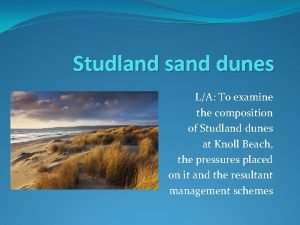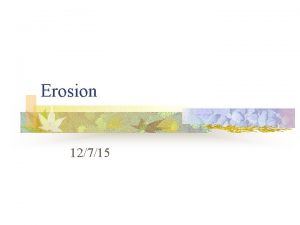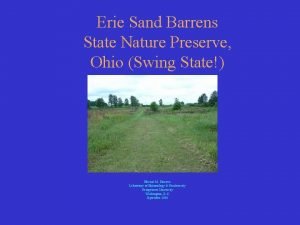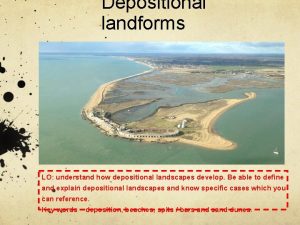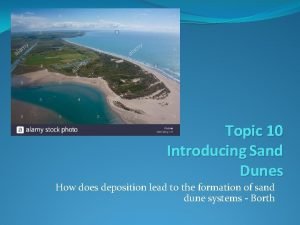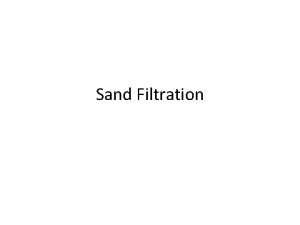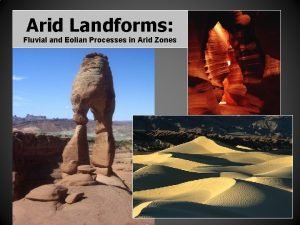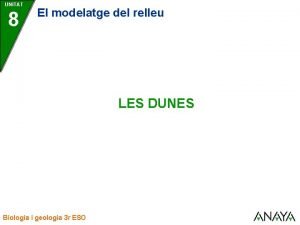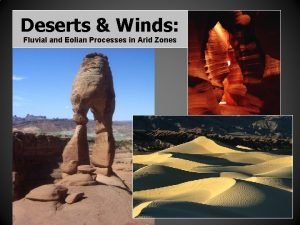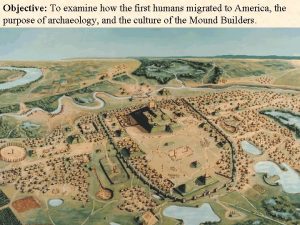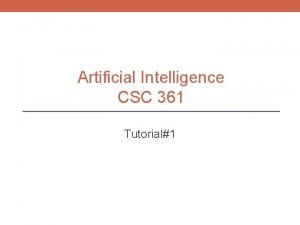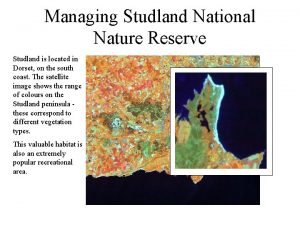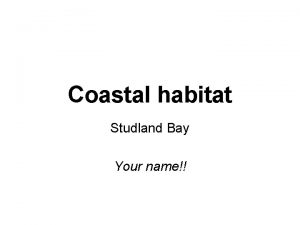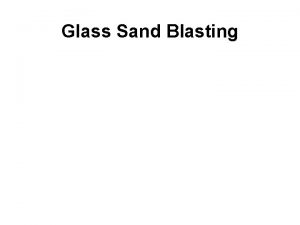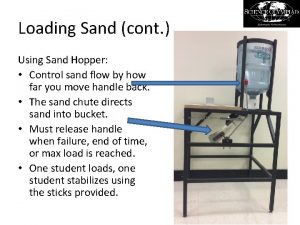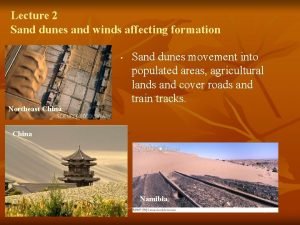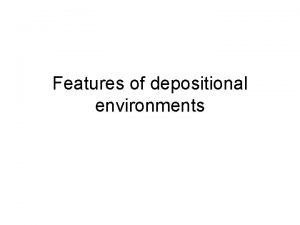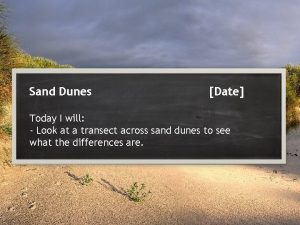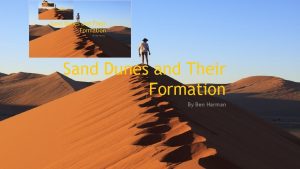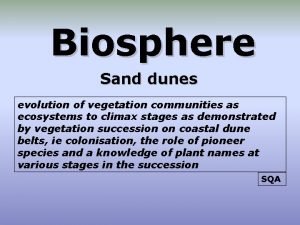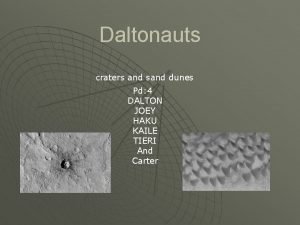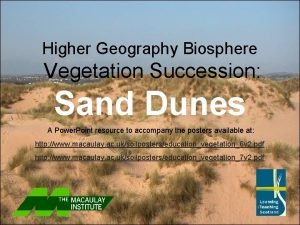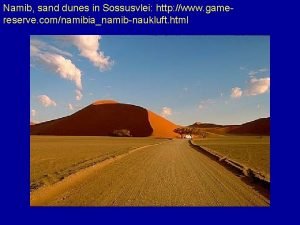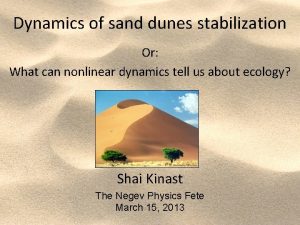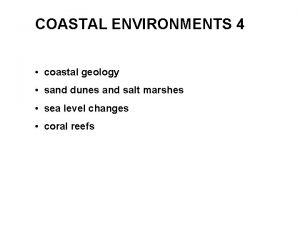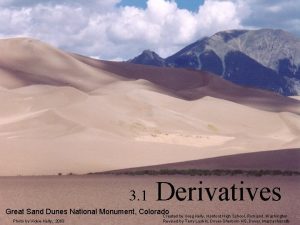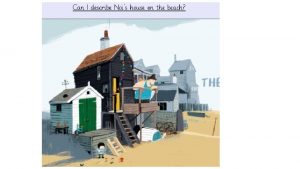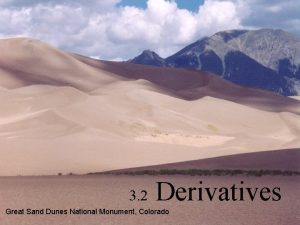Studland sand dunes LA To examine the composition























- Slides: 23

Studland sand dunes L/A: To examine the composition of Studland dunes at Knoll Beach, the pressures placed on it and the resultant management schemes

Development of dunes background �Sand began being deposited on the eastern shore of the Studland peninsula only about 500 years ago: the beach we all enjoy is just the seaward edge of a dune system that has been growing ever since. �In that time the dunes have formed a barrier that has separated Little Sea, a freshwater lake, from the sea itself. At the northern end of the peninsula the dunes are still growing at more than 1 m per year, and the peninsula is nearly 1 km wide �The Studland dunes themselves are unusual, because they are made of acidic sand (clastic content) with very low shell content (biogenic content)

Change over time (1895 & 1991) See hand out

Extent of dunes and footpath erosion

Geology of area

Little Sea (Dune Slack)


Composition of dunes �This acidity means that after about 60 years, when the roots of the marram grass have anchored the sand in place, they become colonised by heather, and most of the Studland dune system is characterised by an unusual habitat known as dune heath. With more than 75 hectares, Studland is the largest area of dune heath on the South Coast. �As well as the marram, the younger dunes are home to an array of wildflowers throughout the summer, with the powder blue sheep’s bit and the golden yellow cat’s ear constant companions

Value of area • Areas such as this are home to rare species of plants and birds such as dragonflies like the four-spotted chaser and birds like Meadow pipits • The area is attractive to tourists because of the dunes and the wide, sandy beach and the heathland ecosystem provides an attractive destination for bird watchers. The beach can get very crowded in summer months. • Visitors need somewhere to park and also demand other facilities, such as paths and public toilets. • Tourists bring their problems such as litter and fire hazards (caused by barbecues and cigarette ends).


Human Impact At any one time in summer there can be as many as 25, 000 people on the beach a day, evidently there is an impact. The impacts include: • Dune erosion and destabilisation • Footpath erosion • Litter and dog mess • Fires • Species disturbance

Arresting Factors �Humans like nature can interfere at times with succession. Any factor that stops succession from occurring is defined as an arresting factor �Arresting factors can be classified and the point at which they stop succession likewise: �Plagioclimax – where factors that stop succession are linked to people : �Sub / Biotic Climate – Where factors that stop succession and linked to nature Discuss (from homework reading Geoactive 250) 1. What are the factors that have arrested succession at Studland? 2. What examples of biotic factors might exist?

Knoll Beach summer

Strategies to combat these include: Board walks on the dune ridges and routed paths Information boards Dutch ladders to protect high vantage points Dog mess bags and bins Fenced off dune regeneration areas – especially those close to facilities • Sited barbeque areas near visitor centre (behind main all seasons car park) • • •

National Trust Facilities Knoll Beach

Boardwalks – to and along beach

Dutch Ladders

Viewing Platform

Knoll Beach Car Park

BBQ area behind car park

Dune regeneration

Activities � 1. Read and Highlight Geoactive 250 to develop your background to the dunes and extend your knowledge of the impacts that tourists are having on this area. �Annotate your coastal management map for Studland dunes. Choose from: Management Methods chosen Viewing platform Timber palisades, Gabion Boxes and Steel Pilings Wooden Board Dutch Ladders walks along and to beach Fenced off area - Seasonal reseeding Parking Dune restoration Reseeding of marram

Homework �Complete January 2001 PPQ �Complete AQA June 2014 PPQ
 Studland dunes
Studland dunes Sand dunes definition
Sand dunes definition Calestegia
Calestegia Define depositional landforms
Define depositional landforms Sand dunes definition
Sand dunes definition Barchan sand dunes
Barchan sand dunes Difference between rapid sand filter and slow sand filter
Difference between rapid sand filter and slow sand filter Perbedaan rapid sand filter dan slow sand filter
Perbedaan rapid sand filter dan slow sand filter Frictional force simple definition
Frictional force simple definition Molding sand
Molding sand Mining company profile
Mining company profile Different types of dunes
Different types of dunes Dunes transversals
Dunes transversals Archers of st hadrian
Archers of st hadrian Eiloan
Eiloan Helping students examine their reasoning marzano
Helping students examine their reasoning marzano Cobol tallying
Cobol tallying Look at the sentences below
Look at the sentences below Pointed object used to examine specimens
Pointed object used to examine specimens Let a man examine himself
Let a man examine himself Examine
Examine Capulet threatens to disown juliet quote
Capulet threatens to disown juliet quote Playing a decent game of table tennis (ping-pong).
Playing a decent game of table tennis (ping-pong). Examine the power 53
Examine the power 53
